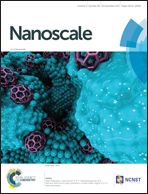Surface-confined [2 + 2] cycloaddition towards one-dimensional polymers featuring cyclobutadiene units†
Abstract
Surface-confined synthesis has been offering a wide range of opportunities for the construction of novel molecular nanostructures. Exploring new types of on-surface coupling reactions is considered essential for being able to deliberately tune the materials properties. Here, we report on the formation of a covalent C–C bonding motif, namely 1,3-cyclobutadiene, via surface-confined [2 + 2] cycloaddition between pyrene moieties using low temperature scanning tunneling microscopy (LT-STM) and X-ray photoemission spectroscopy (XPS) measurements. By employing a hydrogen dosing treatment together with low-temperature activation, we were able to both eliminate residual byproducts and obtain covalent 1D polymers through the formation of 1,3-cyclobutadiene units. The resulting C–C bonding motif has so far hardly been explored in surface chemistry and substantial evidence is provided that the hydrogen treatment is crucial towards the removal of byproducts in surface-confined polymerization.
![Graphical abstract: Surface-confined [2 + 2] cycloaddition towards one-dimensional polymers featuring cyclobutadiene units](/en/Image/Get?imageInfo.ImageType=GA&imageInfo.ImageIdentifier.ManuscriptID=C7NR06187K&imageInfo.ImageIdentifier.Year=2017)
- This article is part of the themed collection: Celebrating Excellence in Research: Women of Materials Science


 Please wait while we load your content...
Please wait while we load your content...